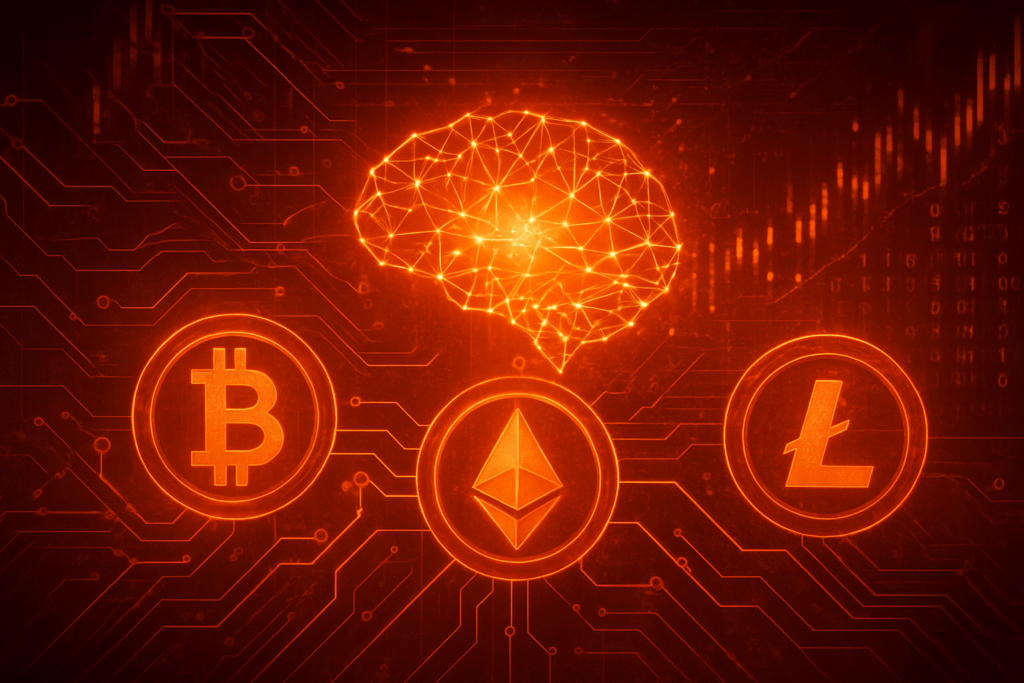
As of late 2025, the cryptocurrency world finds itself at a fascinating crossroads, grappling with the burgeoning capabilities of Artificial Intelligence (AI) models like ChatGPT. The burning question on every investor's mind: can these sophisticated algorithms reliably predict the next crypto market crash? While AI has proven to be an invaluable asset in processing vast datasets and identifying complex patterns, the consensus among experts and the broader crypto community is one of cautious optimism, viewing AI as a powerful analytical tool rather than a definitive crystal ball for market volatility.
The integration of advanced AI into crypto analysis marks a significant evolution in how market participants approach risk and opportunity. These models are adept at sifting through mountains of data—from on-chain metrics and social media sentiment to macroeconomic indicators—to unearth potential warning signs. However, the inherent unpredictability of the crypto market, often swayed by unforeseen "black swan" events and sudden regulatory shifts, presents a formidable challenge that even the most advanced AI struggles to overcome with absolute certainty. This ongoing debate underscores a critical shift in how we perceive technological foresight in volatile financial landscapes, emphasizing the need for a nuanced understanding of AI's strengths and, crucially, its limitations.
Market Impact and Price Action
The advent of AI-driven tools has undeniably refined the landscape of crypto market analysis, offering unprecedented capabilities in identifying potential market shifts. AI models, including sophisticated large language models (LLMs) like ChatGPT, excel at aggregating and recognizing patterns across diverse data points. This includes real-time exchange data, intricate blockchain network activity (such as 'whale' movements, activations of dormant wallets, and significant exchange inflows/outflows), pervasive social media sentiment across platforms like X (formerly Twitter) and Reddit, breaking news headlines, and a spectrum of macroeconomic indicators ranging from inflation rates to geopolitical tensions. This comprehensive data synthesis allows AI to pinpoint complex anomalies that might precede significant market movements, offering an enhanced layer of risk assessment.
Furthermore, AI's prowess in Natural Language Processing (NLP) enables it to perform real-time sentiment analysis, gauging public emotion from countless online discussions. This provides invaluable insights into potential shifts in investor behavior and overall market psychology. Early warning signals, such as extreme 'greed' readings on the Fear & Greed Index, sudden surges in crypto inflows to exchanges (often indicative of selling pressure), the movement of long-dormant wallets, or speculative altcoin pumps lacking fundamental support, are all within AI's analytical grasp. These capabilities significantly improve risk assessment and highlight potential pressure points where substantial market volatility could emerge.
Despite these advanced functionalities, AI's reliability in precisely timing market crashes remains a subject of considerable debate. While AI can effectively identify a buildup of risk, as observed during an October 2025 liquidation wave triggered by unexpected tariff announcements, it struggles to predict the exact moment of a market break. The crypto market's susceptibility to unpredictable external factors—such as novel regulations, geopolitical upheavals, major security breaches, or sudden social media-driven trends—poses a significant challenge. These "black swan" events, by their very nature, deviate significantly from historical data patterns, making them exceedingly difficult, if not impossible, for AI models to anticipate. Consequently, while AI offers "significantly superior predictive capabilities" in crypto compared to traditional markets due to higher data frequency, the inherent unpredictability of digital assets still limits the stability of these predictions.
Community and Ecosystem Response
The prevailing sentiment within both the crypto community and among industry experts regarding AI's predictive capabilities is one of cautious optimism and strategic integration, rather than outright reliance. There's a clear recognition that while AI tools are transformative, they are best utilized as supplementary aids for risk management and data-driven insights. The human element, with its capacity for contextual interpretation and nuanced judgment, remains crucial in navigating the crypto market's inherent volatility.
Crypto influencers and thought leaders frequently emphasize AI's role in processing vast amounts of data and performing emotionless analysis, thereby reducing human bias in trading decisions. Platforms like Token Metrics are often cited for their AI-driven research and prediction capabilities, though even these sophisticated systems typically provide forecasts within probabilistic ranges, consistently underscoring the importance of risk mitigation strategies. While some advanced AI models, such as ChatGPT-4o and ChatGPT-5, have offered bullish price predictions for major cryptocurrencies for late 2025, these forecasts are invariably presented with probabilistic outcomes, acknowledging the underlying market dynamics and inherent uncertainties.
On social media platforms and forums like Reddit, discussions often revolve around the practical applications of AI, particularly the growing use of AI bots for automated trading. These bots offer speed and consistency, executing trades based on predefined indicators and statistical probabilities, free from human emotions that can often lead to irrational decisions. This trend signifies a more mature approach to market participation within the community, where the focus is increasingly shifting towards utility, institutional adoption, and regulatory clarity, moving away from purely speculative fervor. The broader sentiment suggests that while AI can provide valuable insights and "whisper in your ear," investors are encouraged to "trade with your brain, not your heart," using AI to strengthen their trading strategies and manage risk effectively.
What's Next for Crypto
Looking ahead, the integration of AI into cryptocurrency analysis is poised to deepen, becoming an even more indispensable component of strategic decision-making for both individual investors and institutional players. The short-term implications suggest a continued refinement of AI-driven tools, leading to more sophisticated risk assessment models and enhanced capabilities in identifying emerging market trends. As AI algorithms become more adept at processing real-time data and adapting to evolving market conditions, we can expect improvements in detecting potential vulnerabilities and opportunities within the crypto ecosystem.
In the long term, AI's role will likely evolve beyond mere analysis to proactive market participation. This could involve more advanced autonomous trading systems, predictive analytics for tokenomics modeling, and even AI-powered regulatory compliance tools. However, the human element will remain paramount. Investors and projects will need to develop a sophisticated understanding of how to effectively interpret AI-generated insights, recognizing their probabilistic nature and contextualizing them within broader market narratives and unforeseen events. The ongoing challenge will be to strike a balance between leveraging AI's analytical power and maintaining a critical, human-driven perspective to avoid over-reliance on algorithmic predictions.
Potential catalysts to watch include further advancements in AI's ability to process unstructured data, such as real-time geopolitical shifts or nuanced regulatory announcements, which could improve its predictive accuracy for external shocks. The development of explainable AI (XAI) will also be crucial, allowing users to understand why an AI model makes a certain prediction, fostering greater trust and enabling more informed human intervention. Strategic considerations for projects and investors will involve continuously updating their AI models with the latest data, diversifying their analytical tools, and fostering a culture of informed skepticism. Possible scenarios range from AI becoming a cornerstone of proactive risk management, significantly reducing the impact of minor market corrections, to a potential "AI bubble" where over-reliance on flawed models could inadvertently contribute to market instability if unchecked.
Bottom Line
For crypto investors and enthusiasts, the key takeaway is clear: while AI models like ChatGPT represent a monumental leap in analytical capability, they are not infallible prophets of market crashes. They serve as extraordinarily powerful tools for data aggregation, sentiment analysis, and risk assessment, capable of highlighting early warning signs and complex patterns that human analysts might miss. However, the inherent unpredictability of the cryptocurrency market, particularly its susceptibility to "black swan" events and external shocks, means that no AI model can guarantee precise foresight into market collapses.
The long-term significance of AI in crypto lies in its ability to enhance, rather than replace, human judgment. It empowers investors with a deeper, data-driven understanding of market dynamics, enabling more informed decision-making and robust risk management strategies. This means using AI to strengthen your trading strategy, manage risk, and identify potential opportunities, but always with a healthy dose of skepticism and a reliance on your own critical thinking. The ongoing evolution of AI will undoubtedly continue to shape crypto adoption, fostering a more sophisticated and data-centric investment environment.





